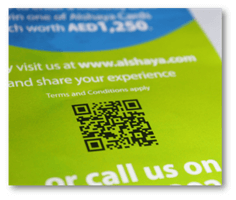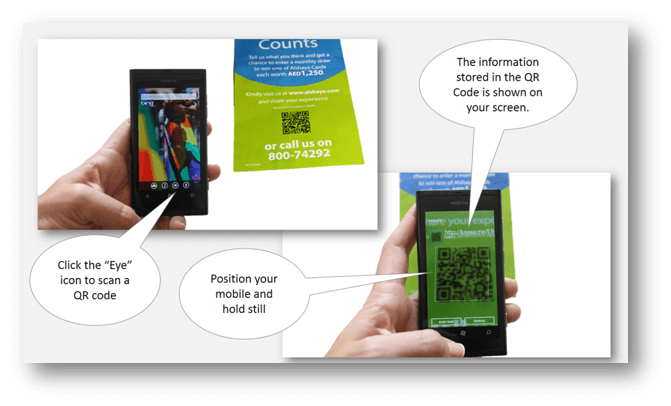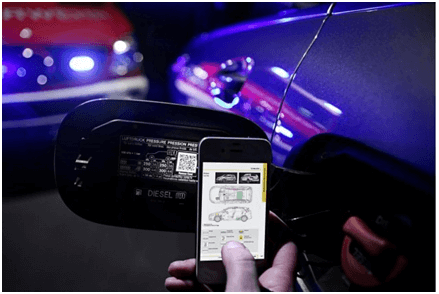What are QR codes and what are its benefits?
 Whether you are in a coffee shop, a retail store or reading a magazine, you probably can’t help notice the black and white squares with funny patterns on products, billboards and ads. These little squares with funny patterns are called QR codes (Quick Response) codes. These are not new, they have been around for quite some time. But still, very few know how to use them and how they would benefit from doing so. In this week’s blog article I give you a quick overview of the technology, show you how you can use it and share some of the benefits of using it.
Whether you are in a coffee shop, a retail store or reading a magazine, you probably can’t help notice the black and white squares with funny patterns on products, billboards and ads. These little squares with funny patterns are called QR codes (Quick Response) codes. These are not new, they have been around for quite some time. But still, very few know how to use them and how they would benefit from doing so. In this week’s blog article I give you a quick overview of the technology, show you how you can use it and share some of the benefits of using it.
Overview of QR codes
The Quick Response Code was developed in 1994 for the automotive industry by a Toyota subsidiary. The QR code is a 2-dimensional barcode that can be read optically, for instance using a mobile phone camera. The code can contain data such as website URLs, product descriptions or vCards (electronic business cards). The original purpose of the QR code was to track vehicles during manufacturing. Today QR codes are primarily used for advertising, linking printed media with online media (such as websites, YouTube videos or online product brochures). Another usage area for QR codes that is growing in popularity is for mobile payments. Using QR codes is free, it doesn’t require any form of license. QR codes are not the only way to link the printed and online world, other technologies include Microsoft Tags and NFC (Near Field Communication), but more on those in another blog post.
How to scan a QR code
You can scan a QR code using your mobile camera. In some cases, you need to download an app to scan QR codes. Just do a search for “QR” in your mobile app store and you will find many apps for free that you can download. If you have a Windows Phone you don’t need to download a separate app, you can scan QR codes directly using Bing. To scan a QR code, open up Bing, press the “Eye” icon and point your mobile phone camera to the QR code and hold still. The camera will identify the code and present the information in the code on the screen.
Examples of great QR code usage
There are numerous examples of great QR code usage. One example that sticks out is the Mercedes-Benz QR code initiative which aims to save lives. In Germany, car manufacturers are required to provide a “rescue sheet” with each car sold. This rescue sheet contains information about the placement of everything from fuel lines to airbags, pressurized cylinders, and the high-voltage cables – vital information for paramedics, police and firefighters to have so that they don’t accidentally cut into something that might explode.
In order for the rescue personnel to quickly get access to these rescue sheets, Daimler (Mercedes parent company) are going to place QR codes stickers on Mercedes-Benz cars. One QR code sticker will be placed behind the fuel door and another on the roof support on the opposite side of the car (according to Daimler this is the optimal placement for easy access and it’s unlikely that both places will be destroyed in a car crash). Using the QR codes, rescue personnel can quickly access fundamental information about the car via their mobiles within seconds, and hopefully be able to save more lives.
Benefits of QR codes
There are a number of benefits of using QR codes. As a user, you get instant access to more information about a product, service or initiative directly from your mobile. You don’t have to type anything into your mobile, by just using the camera and scanning the QR code, all information stored in the QR code is available via your mobile phone. You can keep a digital archive of this information in your phone and go back at any time. As a QR code publisher, a great benefit is that you can provide more information to the user and you can keep this information up to date. Say for instance that you want to start a campaign where you provide daily discounts and offers depending on the number of engaged customers. Using a QR code in your printed advertising you can link users to a website that is updated daily based on the number of people who scan the QR code and go to the campaign website. As a QR publisher, you can get more insights into how your printed advertisement campaign is doing through rich analytics. You can measure the number of users and you can analyze their behavior once they come to your site. Since the QR technology is free to use, anyone can create a QR code and publish to desired media.
The future will tell which technology prevails
The QR technology has been around for many years, and even though you see the QR codes in a lot of places, the adoption of the technology has been quite slow and frequently questioned. As I mentioned above, there are other technologies that enable printed information to be transferred via cameras to mobile phones. Unfortunately, I don’t have a crystal ball or other insights to tell you which technology will prevail. Only time will tell what or which technologies we will be using in the future to merge the physical world with the digital world.
(If you have difficulties reading this article, you can access the full article in pdf here)



